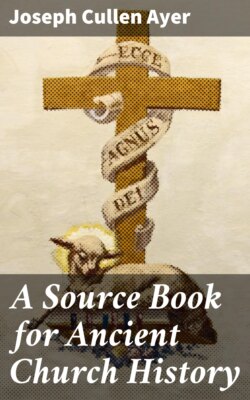Читать книгу A Source Book for Ancient Church History - Joseph Cullen Ayer - Страница 55
На сайте Литреса книга снята с продажи.
Period III. The Critical Period: AD 140 to AD 200
ОглавлениеTable of Contents
The interval between the close of the post-apostolic age and the end of the second century, or from about 140 to 200, may be called the Critical Period of Ancient Christianity. In this period there grew up conceptions of Christianity which were felt by the Church, as a whole, to be fundamentally opposed to its essential spirit and to constitute a serious menace to the Christian faith as it had been commonly received. These conceptions, which grew up both alongside of, and within the Church, have been grouped under the term Gnosticism, a generic term including many widely divergent types of teaching and various interpretations of Christian doctrine in the light of Oriental speculation. There were also reactionary and reformatory movements which were generally felt to be out of harmony with the development upon which Christian thought and life had already entered; such were Montanism and Marcionism. To overcome these tendencies and movements the Christian churches in the various parts of the Roman Empire were forced, on the one hand, to develop more completely such ecclesiastical institutions as would defend what was commonly regarded as the received faith, and, on the other hand, to pass from a condition in which the various Christian communities existed in isolated autonomy to some form of organization whereby the spiritual unity of the Church might become visible and better able to strengthen the several members of that Church in dealing with theological and administrative problems. The Church, accordingly, acquired in the Critical Period the [pg 051] fundamental form of its creed, as an authoritative expression of belief; the episcopate, as a universally recognized essential of Church organization and a defence of tradition; and its canon of Holy Scripture, at least in fundamentals, as the authoritative primitive witness to the essential teachings of the Church. It also laid the foundations of the conciliar system, and the bonds of corporate unity between the scattered communities of the Church were defined and recognized. At the same time, the Church developed in its conflict with heathenism an apologetic literature, and in its conflict with heresy a polemical literature, in which are to be found the beginnings of its theology or scientific statement of Christian truth. Of this theology two lines of development are to be traced: one a utilization of Greek philosophy which arose from the Logos doctrine of the Apologists, and the other a realistic doctrine of redemption which grew out of the Asia Minor type of Christian teaching, traces of which are to be found in Ignatius of Antioch.
